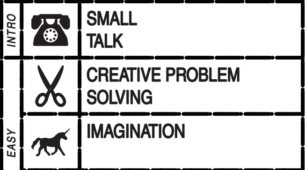For this week’s playtest, I playtested Contact, a verbal word game, with three of my friends. Like Mafia/Werewolf, Contact can be considered a folk game, given that it is largely passed down from generations. Unlike Mafia/Werewolf, however, there doesn’t seem to be a known creator for Contact. Contact is a group word-guessing game for a minimum of three players total, with a broad, unspecified target audience, although it might be more fun for players over 12, as they gain a better sense of wordplay and vocabulary. Contact also has no physical materials, making it a versatile road trip game.
In Contact, one player picks a word, which is not revealed to the other players, but to start the game, they reveal the first letter of the word. The rest of the players try to guess the word by earning letters, by making “contact.” That is, one person thinks of a word that starts with the given letter, and gives a verbal clue as to what word they’re thinking of. Another player can then make contact if they think they also know the word. If two non-clue-givers make “contact,” the clue-giver must reveal the next letter of the secret word. However, “Contact” can be blocked by the clue-giver if they guess it before the rest of the players do. The game is continued until the secret word is either guessed or fully revealed.
Mechanically, our game and Contact are not very similar; Contact is a game that revolves around vocabulary and clue-giving, whereas our game is more about creativity, knowledge of the other people / guessing, and deception.
However, similar to our game, Contact also draws fun from the psychogenic need for information— that is, both Contact and our game include elements of cognizance (seeking knowledge) and exposition (giving information, demonstrating) although both are also veiled by a layer of mystery (Lecture 3B). Thus, both have fundamental aesthetics of fellowship. However, our game also brings in the aesthetic of deception, an aesthetic that Contact does not necessarily have, or at least, not explicitly (MDA + 8 Kinds of Fun). Both offer a socializing, bonding experience for its players. However, our game may sidestep the exclusivity pitfall that Contact may sometimes have.
Both Contact and our game target a group of players that want to become closer together; both games bring players together by creating moments where players share information with each other.
In our game, the psychogenic need for information is demonstrated through the King, who is seeking knowledge— who the Queen might be— and the Queen, who is trying to give the King the information of her identity through her written response. In this way, the fellowship aesthetic is also created in our game. The mechanics of the King and Queen trying to seek each other form the dynamic of a team, which produces a fellowship aesthetic. On the other hand, the commoners work together, each pretending to be the Queen, which also builds this fellowship aesthetic, although on the opposing side.
Similarly, a player in Contact is giving information, playing on a psychogenic need, when giving a clue, seeking knowledge by earning letters, as well as piecing together the letters given to ultimately arrive at the word. Also, although it is rare for the clue-giver to actually win (the only “winning” condition is really if the other players can’t guess the word, which is rare), they are nevertheless engaged in the game, as they can block “Contact” from being made, and are actively engaging in processing and demonstrating knowledge. In a slightly different way, even though Contact is also a game with fellowship as one of its main aesthetics, it accomplishes this aesthetic through the mechanics of the non-clue-guessers making contact. Thus, although the word-giver is actively engaged in the information exchanges, they have no fellowship in that they do not work with other players.
However, it is interesting that despite the formation of two opposing sides, competition is not a main aesthetic in either Contact or in our game. For example, in Contact, the word-giver does not necessarily derive fun from “winning”; the word-giver really cannot win unless they come up with a very obscure word. I tried this one round, with my very, very little remaining knowledge from AP Bio. It wasn’t very fun, because everyone got stuck, and although I did “win,” it was actually less fun to have stumped the rest of the players, as perhaps one of the main aesthetics of Contact is the psychogenic need for information exchange.

Figure 1: Quotes of a guessing round with me as the word-giver, using a purposefully tricky word.
(The word was echinodermata. Could not tell you anything about echinodermata now, other than most people probably wouldn’t guess the word.)
So, it seems that (at least, in my playtesting) the word-giver derived fun from participating in guessing, and arriving at the necessary information exchange before the other players. Although the information exchange in our game is less explicit, our game also seems to be designed for players to gain pleasure from being able to seek, give, and recognize information (e.g. a certain player’s writing style, hidden messages between the King and Queen, etc.)
Where our game differs most drastically from Contact, however, is in its aesthetic of potential deception. It is assumed that the commoners will attempt to deceive the King, and try to take on or guess what the Queen might write, as that is what they must do in order to win. On the other hand, one cannot lie in Contact. The word-giver must give the letters accordingly, and there is absolutely no incentive for the other players to trick each other or give bad, misleading, or false clues.
Where the games are again similar, however, is in how they might be played differently among strangers compared to with close friends. Contact, for example, might actually expose some closer bonds between friends, which might be natural. However, this can also get frustrating and exclude people, even within a friend group.

Figure 2: Quotes of another guessing round with a different word (“strawberry”) with two friends who had went to see Memoir of a Snail in Fall Quarter.
Inside jokes can be an advantage to get around the word-giver, which might sometimes feel exclusive, but as the word-giver role rotates, it is not too uncomfortable.
Our game is designed for a group of friends. However, I predict that our game might be less risky in terms of exclusivity for a friend group, even with varying degrees of closeness, as there’s a lower probability that the King and Queen happen to be a pair of the closest friends; even if they are, it is only for a round. The stakes also seem to be lower, and the inside jokes shared, if at all, will also be more vague, as the responses all also have to follow a prompt. As we discovered in playtesting in class, however, the mechanics of guessing might be difficult for a group of perfect strangers (which is why we wanted our target audience to be friends.) To make the game more accessible though (for strangers as well as friends), we might consider adding an external identity or secret constraint for the Queen (while maybe also making the roles secret) to aid strangers in guessing / exchanging information without needing to know the other players personally at all.



